Last Updated on October 17, 2024 by Kittredge Cherry
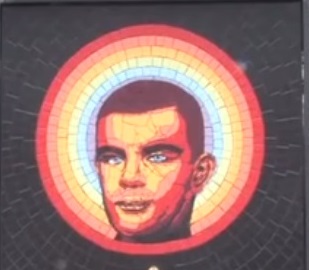
Alan Turing is a gay icon, pioneering computer scientist and British codebreaker. He is sometimes called a gay saint because his wartime codebreaking saved millions of lives, and a gay martyr because he was driven to suicide by court-ordered “chemical castration” hormone treatments after his conviction for homosexuality.
His spiritual side highlighted in artwork such as a mosaic of Turing with a rainbow halo and in the work of queer British artist Tony O’Connell. He made a photographic record of his recent trip to the Alan Turing Memorial in Manchester, England — an act that served simultaneously as pilgrimage, performance art and political statement. Tony O’Connell even created an image of Turing with the founder of Q Spirit.
Alan Turing saved many lives
Turing (June 23, 1912 – June 7, 1954) played a major role in winning World War II by breaking Germany’s complex Enigma code. He worked out of Bletchley Park, a mansion that served as a top-secret government decryption center in Buckinghamshire. Historians estimate that Turing saved more than 14 million lives by breaking the Enigma code and thereby shortening the war by two years.
He also broke the code against homosexuality. His wartime work was top secret, so nobody knew of his contributions when he was tried and convicted of homosexual acts in 1952. His security clearance was revoked and he was given a choice between imprisonment or probation with “chemical castration” through female hormone treatments. He accepted the hormone injections.
Disgraced and forgotten, Turing committed suicide in 1954 at age 41. There is also a theory that he was murdered by the British secret services because they considered him a security risk.
He has received a growing number of honors in the years since his death. The British government officially apologized in 2009 and the queen granted him as posthumous pardon in 2013. Again Turing helped others, because when his conviction was overturned, it cleared the way for pardons of about 50,000 other men convicted under the same law.
Turing was raised in the Anglican church, and there is debate about whether he became an atheist or continued to have respect for religion and faith in a higher power. His paternal grandfather, John Robert Turing Jr., was a clergyman.

Young Alan Turing considers how two can become one flesh in the arithmetic of gay dating in a page from “Heavenly Homos, Etc.: Queer Icons from LGBTQ Life, Religion, and History” by Jan Haen.
Turing’s life story is told in in the 2022 book “Heavenly Homos, Etc.: Queer Icons from LGBTQ Life, Religion, and History” by Dutch artist and Redemptorist priest Jan Haen. He includes scenes that are rarely if ever portrayed by artists, such as young Turing thinking that “1 + 1 = 1” means two gay men becoming one when they make love. Finding that traditional logic is not always true, Turing developed the insights that led him to his code-breaking contributions. Haen’s illustrated book is a graphic non-fiction mini-documentary covering about 30 figures from all over the world. His unique approach combines ripped-from-the-headlines immediacy with progressive spiritual sensibility in a modern Pop-Art style.
The definitive biography of Turing is “Alan Turing: The Enigma” by Andrew Hodges. His life is also chronicled in the documentary film “Codebreaker.” The first major motion picture to dramatize his story is the 2014 movie “The Imitation Game.” It stars Benedict Cumberbatch as the eccentric genius who broke many codes. There is even a bestselling historically accurate graphic novel “The Imitation Game: Alan Turing Decoded” by by Jim Ottaviani and Leland Purvis.
Artist makes Turing pilgrimage
Democratizing the idea of sacredness and reclaiming the holiness in ordinary life, especially in LGBTQ experience, are major themes in O’Connell’s work. Based in Liverpool, O’Connell was raised in the Roman Catholic church, but has been a practicing Buddhist since 1995.
“For me Alan Turing is so important because his work shortened World War II (some believe by between two and four years) and by doing so he caused millions of lives — on both sides — to be saved,” O’Connell told the Jesus in Love Blog at Q Spirit. He added that Turing “laid the groundwork for the modern computer industry and even artificial intelligence.”
In 2014 he decided to add Turing to ongoing series of LGBT pilgrimages. Previous pilgrimages took him to the Harvey Milk Metro station in San Francisco Metro and New York City’s Stonewall Inn.
“For the LGBT community the nature of his death, that he was driven to suicide by the homophobic legislation of the period not only speaks of a profound lack of government gratitude for his work but also of an enshrined homophobia which perceives a personal consensual relationship as more important than the saving of so many thousands of lives and the advances thereof. It was for these reasons I felt this most recent pilgrimage had to be to the statue of him in Manchester to regard it as a holy place,” O’Connell said.
The Turing pilgrimage photos begin with the artist at a canal in Manchester. O’Connell removes his shoes to walk barefoot on the holy ground along the canal toward the Turing memorial.
The heart of the memorial is a life-sized sculpture of Turing. The bronze figure sits alone on a bench located between the local gay neighborhood and the University of Manchester, where he taught mathematics. It was sculpted by Glyn Hughes.
O’Connell puts his hands together in prayer as he greets the Turing statue. He communes with the saint in various ways, offering seven silver bowls of holy water at Turing’s feet. The artist cleanses the rainbow mosaic embedded in the pavement and bathes them with holy water. The ritual ends when O’Connell pours the water into the canal in the middle of the gay village. Photographer Damian Cruikshank recorded the whole journey.
“It has often been a theme in my work to reclaim religious imagery in a secular way to discuss LGBT issues, but this time it felt more spiritual than I would have expected,” O’Connell recalled.
After returning from the pilgrimage, he created an embossed foil icon titled “Saint Alan Turing Ora Pro Nobis.” The Latin phrase, which means “pray for us,” is repeated in the traditional Litany of the Saints.
O’Connell is also doing an ongoing series of photos of people with haloes formed by round objects from daily life, such as light fixtures, mirrors, windows, baskets, and the sun. “We do not need the permission of anyone else to see perfection in each other,” he explained.
Alan Turing and Q Spirit founder pictured together
O’Connell took the initiative to create an image of Turing together with Q Spirit founder Kittredge Cherry. They may seem like an unlikely pair, but Cherry writes about gay saints and martyrs — and Alan IS one. “I produced the drawing firstly as gift in gratitude for how much you understood my work. (Almost like a code breaker yourself!),” O’Connell told Cherry.
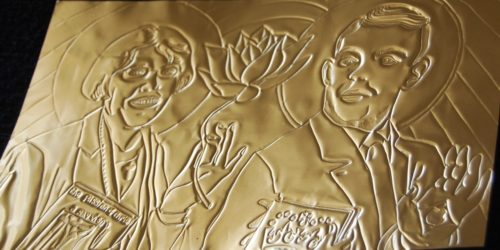
“Blessed Kitt Cherry meets Saint Alan Turing” by Tony O’Connell
The embossed copper relief sculpture shows Cherry on the left carrying her book “The Passion of Christ: A Gay Vision” in one hand and a lotus flower in the other. She makes a “mudra” (symbolic hand gesture) for teaching, while Turing’s gesture indicates fearlessness.
O’Connell shipped the copper foil portrait overseas from Liverpool to Los Angeles as a gift with the following handwritten text: “Blessed Kitt Cherry with the Vitarka Mudra meets Saint Alan Turing with the Abhaya Mudra in the Pureland ‘Rainbow radiance in the ten directions’ to rejoice in the Lotus offering of human potential, fearlessness and dignity.”
Later O’Connell explained the symbolism in greater detail:
“The Mudras I wanted to use were the start of it and his fearlessness gesture is often balanced in Buddhist and Hindu iconography with the Mudra of expounding wisdom. It suggests teaching as the fingers look like they are defining a very specific point- in Eastern thinking it is also suggestive of completing a circle or Dharma wheel which is again a symbol for eternity and it seemed like for all your hard work in showing the overlooked side of our own spirituality that had to be your one. It also often serves to hold the lotus or other offering flower so that seemed appropriate too.
His stigmata is the Apple logo (Which is obviously a conflation of ideas and they do not claim that the idea for it came from Alan Turing’s martyrdom but for me the symbolism is unavoidable). I also wanted his folder of notes from Bletchley Park to have the current government department logo which is a crown. The martyr’s crown was essential to fit in somehow and I also wanted to suggest the possibility of a unique level of reward in terms of a paradise for LGBT people.”
Mosaic shows Alan Turing with rainbow halo
Turing appears with a rainbow halo in a larger-than-life memorial mosaic by Rita Gav and Alan Butt of Icon Mosaics. The street tribute was hailed as the first public monument to recognize Turing as gay when it was unveiled on his birthday in 2014. Built from thousands of porcelain tiles, it features a timeline of his life. A video records its dedication in 2014 at Pink Punters, a nightclub in Buckinghamshire near Bletchey Park.
Alan Turing from Pink Punters on Vimeo.
More visions of Alan Turing
“Alan Turing, the Soul of the Man Beyond the Verdict, Beyond the Machine” is an artistic video tribute to Turing by gay artist Stephen Mead of New York. “I like the idea of these images… hovering like holograms in space, as does the energy of Turing,” Mead explains. He is the author of “Our Book of Common Faith” and other books. For more about Mead and his art, see the previous post “Gay Artist Links Body and Spirit.” His Chroma Museum website features more than 500 montage images from his series on historical LGBTI figures and allies.
Turing is also depicted in the 1986 stage play “Breaking the Code” by Hugh Whitemore. Derek Jacobi as Turing took London and Broadway by storm, and later starred in the BBC / PBS television film version.
Alan Turing prayer
Q Spirit’s Litany of Queer Saints includes this line:
Saint Alan Turing, British computer scientist whose wartime codebreaking saved millions of lives, martyred by anti-gay laws, pray for us.
___
Top image credit:
Alan Turing mosaic by Rita Gav and Alan Butt of Icon Mosaics, taken from screenshot of dedication video at Pink Punters
___
Related links:
“Station 6: Gay Scientist Alan Turing Driven to Suicide” from “LGBT Stations of the Cross” by Mary Button
___
For more art by Tony O’Connell on the Jesus in Love Blog, visit:
Orlando martyrs: Pulse gay nightclub massacre recalled in art and prayer
Tony O’Connell reclaims sainthood by finding holiness in LGBT people and places
New art film highlights queer saints, Sebastian and homophobic violence for All Saints Day
Olympics: Spiritual art supports Russia’s LGBT rights struggle
___
This post is part of the LGBTQ Saints series by Kittredge Cherry. Traditional and alternative saints, people in the Bible, LGBT and queer martyrs, authors, theologians, religious leaders, artists, deities and other figures of special interest to lesbian, gay, bisexual and transgender and queer (LGBTQ) people and our allies are covered.
This article was originally published on Q Spirit in June 2019, expanded with new material over time, and most recently updated on June 7, 2023.
Copyright © Kittredge Cherry. All rights reserved.
Qspirit.net presents the Jesus in Love Blog on LGBTQ spirituality.





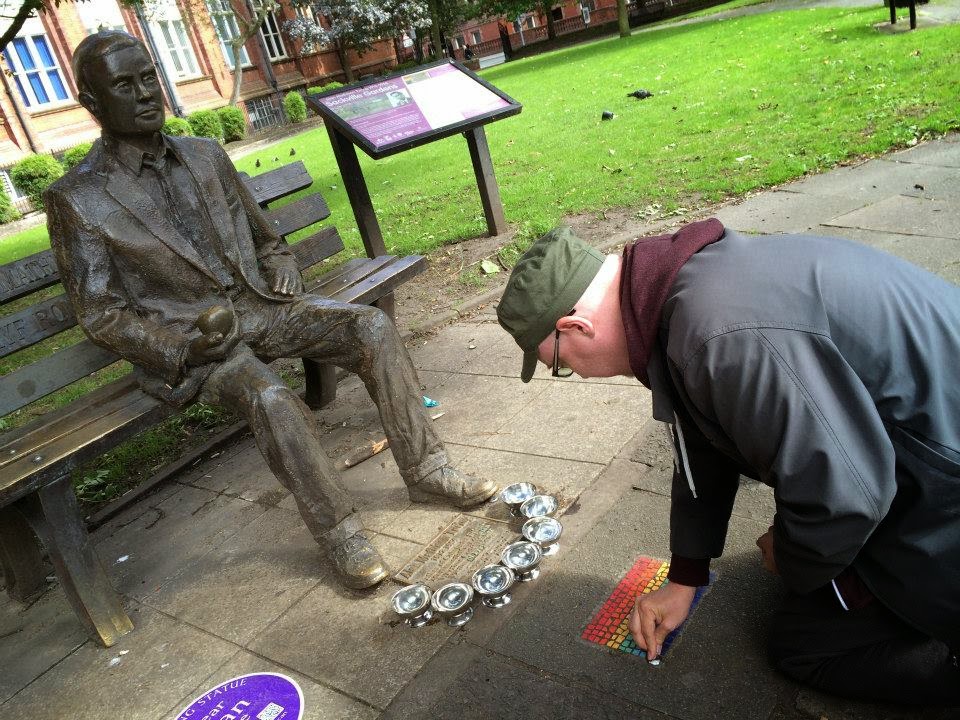



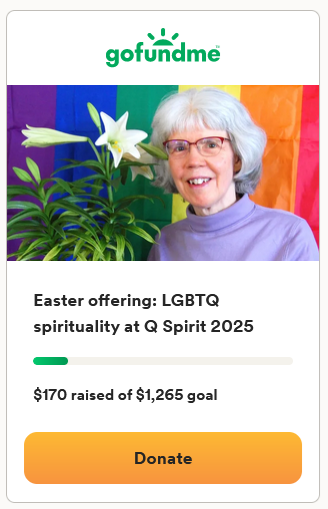















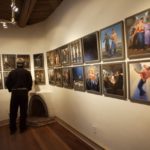
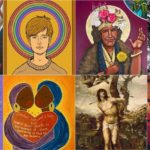


Turing did not commit suicide, however.
thank you for writing this…Frank